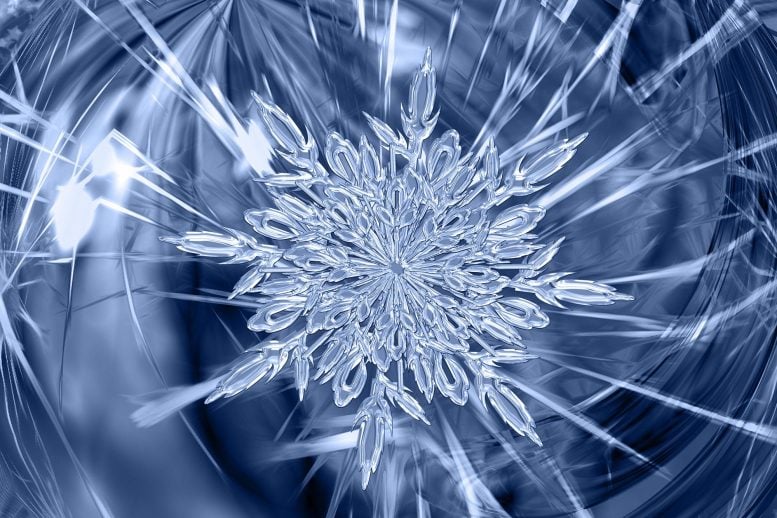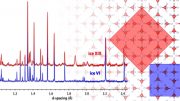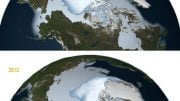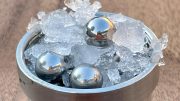
Ice is not as simple as it seems, with at least 20 known forms and potentially thousands more. The most familiar type is ice Ih, which has a hexagonal molecular structure, and is found in the biosphere. Other forms of ice, such as ice III, V, VI, and VII, can be found in extreme conditions on icy moons in our solar system, or even trapped in diamonds deep within Earth’s crust. Ice can be hydrogen-disordered or hydrogen-ordered, depending on the orientation of the water molecules within the ice crystal. With more types of ice being discovered, such as ice XIX and ice XX, our understanding of ice and its various structures is continually evolving.
Ice is a complex substance with at least 20 known forms and possibly thousands more. Found in various environments, from icy moons to Earth’s crust, ice can be hydrogen-disordered or hydrogen-ordered. As new forms like ice XIX and ice XX are discovered, our understanding of ice continues to grow.
There are somewhere between 20 and 74,963 forms of ice because water can do all kinds of weird stuff when it freezes. So far, scientists have experimentally determined the crystal structures for 19 types of ice. Or maybe 20, depending on who you ask. In this video, we’re going to charge through as many as we can in 10 minutes or so.
Video Transcript:
I just wanna talk about ice.
The weird properties of water, thanks to our favorite hydrogen bonds that cause ice to be less dense than liquid water, are key to life on Earth.
But ice itself is pretty boring.
It’s got some ordered hexagons. The solid configuration is less dense than the liquid form, makes our ice tea nice and cold and it forms some pretty snowflakes, but that’s kinda it, right?
No, wrong. Ice is fascinating.
I’m gonna prove it to you.
Ice is amazing.
(upbeat music)
We’re talking about ice.
Is this delivery too weird or is it not weird enough? Nobody knows.
Not only is ice fascinating, but all that stuff I just mentioned is right here.
It is ice I, but there are also all these other kinds of ice plus more that can’t even be represented here.
We don’t even know how many kinds of ice there are. We have found about 20 so far, but there could be as many as 74,963.
So it’s somewhere between 20 and 74,963.
Each kind has its own structure and properties and some of them are found in diamonds or on Galilean moons. And we are going to talk about all of them. Or like the 20-ish we know about, I mean not all, 74,963.
Let’s start with the ice that we’re all pretty familiar with, ice I.
If you take liquid water at normal atmospheric pressures and cool it to zero degrees Celsius, it’ll align itself into hexagonal crystal in structures.
Ice is actually considered to be a mineral because it is a naturally occurring solid with an ordered structure.
Pretty much all ice in the biosphere, which is the part of the Earth where all the living stuff is, is this kind of hexagonal ice one also called ice Ih.
That hexagonal molecular structure is what helps seed the hexagonal structure of snowflakes. But there’s also a little bit of cubic ice I or ice IC which as the name applies, has a cubic structure.
And this exists at temperatures between 130 and 220 Kelvin and might actually occur way up high in our atmosphere.
There’s also probably a little bit of stacking disordered ice one up there too, which is like a metastable ice that exists somewhere between cubic and hexagonal ice. And that also helps give snowflakes their threefold symmetry.
But what happens if you subject ice to all kinds of temperatures and pressures to force it into other configurations?
That is what this diagram is all about. This is key to everything we’re gonna talk about. So let’s take a closer look.
What we’ve got here are phases of ice at different temperatures and pressures.
The X axis is pressure from low to high and the Y axis is temperature.
Here in orange, we have ice Ih at pretty normal ambient temperatures and pressures.
Now you can change the phases of most materials by changing the temperature or pressure that they’re under. And we are super familiar with this, right?
So changing the temperature of water can change the phase it’s in from a solid to a liquid or a gas. And changing the pressure can have some effect too, but with ice, it doesn’t just stop at solid.
Imagine the hexagonal crystal structure of ice Ih. If you subject that to much, much colder temperatures or much, much higher pressures you can deform and change that molecular structure into all of these other shapes.
So what if we go this way on our chart and we look at ice at higher pressures. And I should mention that these pressures are really, really higher. We are looking at mega and gigapascals.
A gigapascal is 1 billion pascals.
Your bike tire might be around 500 pascals. So this is 2 million times more pressure than that. It’s a lot of pressure.
And if we apply that pressure, we start to move into things like ice III where the hydrogen bonds start to bend and compress, and then we get to ice V, which has rings with both more and fewer water molecules than our hexagonal ice.
And then if we keep adding pressure, we get to ice VI and we get to ice VII.
Now look, the numbers just indicate the order that they were discovered in, not anything about their actual structure. But this first batch of ices I, III, V, VI, and VII are likely found on icy moons in our solar system. Places like Jupiter’s moon, Ganymede.
On these moons, the layers of ice could be up to a thousand kilometers thick causing huge amounts of pressure on the bottom layers, forming these other phases of ice.
When ice is compressed like this to give different phases, it is called a density-driven transition.
And amazingly, that can also happen here on Earth. Ice VI and VII have been found in diamond inclusions deep in the Earth’s crust.
So you can pull up a diamond and find ice VI and VII trapped inside.
Because of this, they have also been designated as minerals. They can be indicators of water deep in Earth’s mantle and it’s possible that they can contribute to friction between slabs of earth that could lead to ice quakes. Ice quakes!
Now if we zoom in on the structure of ice VI, I think this one is really, really cool.
It’s actually composed of two sublattices that fit inside one another, but aren’t connected. There are no hydrogen bonds between the two so they just kind of nestle together. They’re not connected, they’re just hanging out.
Now what if we go the other way on the graph and turn the pressure to negative,
essentially stretching ice.
Well, what we can actually get are forms of ice that are less dense than ice I, things like ice XVI and XVII, these are empty clathrate hydrates.
Clathrates are molecular cage structures that often enclose another molecule. So these are basically big empty cage structures.
Typically, these are made in the lab by forming the cage structure around another molecule, something like neon and then vacuum pumping all of those cage molecules out.
Now if you let the pressure come back to ambient pressure the structures will typically collapse back to ice I unless you keep the temperature really, really low.
What is this? This is zero Kelvin, it’s real low.
Now there’s something I haven’t mentioned yet about all of the ices we have talked about so far. They are hydrogen-disordered ices.
This means that if we zoom in to the tetrahedral bonds surrounding a water molecule in the ice crystal, the center water molecule could be oriented in any direction. And that’s confusing so I made a model, hold on.
(balls screeching)
Hello, this is my art project. And if we think way back to gen chem or our video on water weirdness, what we’re talking about here is actually changing the hydrogen dipole or the separation and orientation of the charges on the water molecule.
So remember, all we care about is the orientation of this center water molecule. If you were to zoom into an ice crystal, it could be oriented like this or if the water molecules around it were in say, this position, we still have these four bonds, but now the dipole is pointing in a different direction.
So before it was going this way and now it is going this way, but there are some phases of ice that are hydrogen-ordered ices. This means that there are favored configurations for the hydrogen dipole rather than just random ones.
And often the disordered and ordered ices can be found in pairs. So if you cool many of the ices that we talked about down, you can go through an entropy-driven transition Entropy driven transition where moving, again, down this figure, so lowering the temperature you can find that their ordered match.
For example, ICE XV is an ordered form of ice VI right there, one’s right below the other.
There is six pairs that we know about right now. For each of these pairs, you’re lowering the temperature and therefore you’re lowering the entropy so you’re getting more order.
I love when things like that make sense like that made sense in my brain when I read it.
One of the newest addition to the lineup is ice XIX. Ice XIX was first described as an ordered form of ice VI that used to be called ice beta XV. So goes right there.
But newer work has shown that it may be better described as a distorted version of ice VI and it might just form at higher pressure. So it might actually go a little closer to over here.
There is ice controversy around where some of these boundaries lie. And I love that controversy means that science is happening.
But you can even look for structures that don’t fit on this graph.
We are talking about some really weird conditions.
So for example, if you take ice VII and you compress it to 50 to 300 gigapascals, you can get to ice X.
And ice X is strange because the water molecules aren’t even water molecules anymore because the hydrogen bonds become symmetrical between the oxygen that you cannot assign a hydrogen to a single oxygen anymore.
(Alex inhales deeply)
And if you heat it to over 2,500 Kelvin, it doesn’t melt. Instead it turns into ice XVIII, which undergoes super ionicity where the oxygen stay in a lot of structure and the hydrogens just kind of move around them.
Now this hydrogen mobility means that ice XVIII may be as conductive as some metals and it is possible that ice XVIII is hanging out in the center of really dense and hot planets like Uranus and Neptune.
And there’s also another super ionic form of ice described in October 2021 that is angling for the title of ice XX.
And look, we’ve been looking at most of these as like ball and stick models so far, but we can also look at them as 3D structures like this.
Here you can see that ice Ih and ice II both have what’s called these open channel structures. That’s really obvious there.
While in ice XVI, you can much better see those expanded clathrate cages that I talked about before.
Here, it is easier to see how pressure can really deform the structures to create things like ice V and VI and VII. They are clearly much more dense than ice I.
Additionally, this diagram only shows these stable forms of ice while there are also metastable phases like ice IV and ice XII.
Disordered forms of ice that only exist in small intermediate conditions, which is why they just don’t have a stable position here on our graph.
But there’s also amorphous ice.
Amorphous ice doesn’t have a long range order to its structure often because it has been cooled so quickly that there just wasn’t time for a lot of structure to form.
There’s no nice order like any of these that goes on forever. It’s just like water molecules randomly arranged kind of like liquid water, which is why it’s called amorphous ice.
It’s actually the dominant form of water in the universe, as far as we know. No one’s out here measuring every single chunk of ice.
But amorphous ice occurs on things like interstellar dust and in places like Saturn’s rings.
There is a lot of it out there.
So much in fact that it might just deserve a video of its own.
Let us know.
Do you wanna know about amorphous ice? I do.
So is that it? Do we just stop at 20-ish phases of ice and call it a day?
Absolutely not.
In fact, a recent computational study found the potential structures for 74,963 types of ice.
So no, science is not done with ice structures, but to name a structure to add to that Roman numeral list, you have to experimentally show the crystal structure.
And so for now, we’re still waiting on ice XXI.
But here, I think, our scientists disagree, so I’m also gonna do a take with ice XX.
And so for now, we’re still waiting on ice XX.









Be the first to comment on "74,963 Kinds of Ice [Video]"